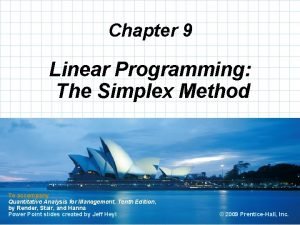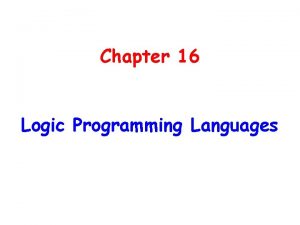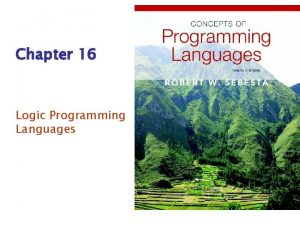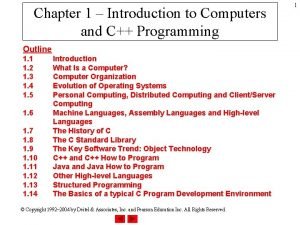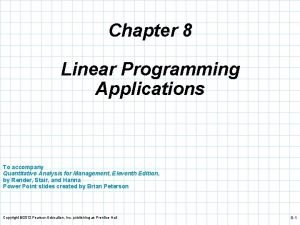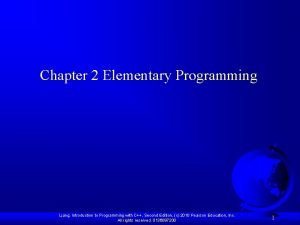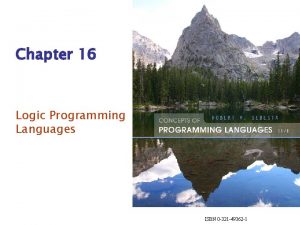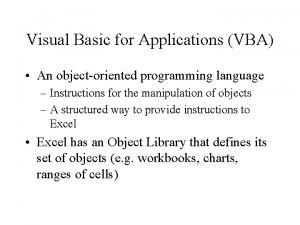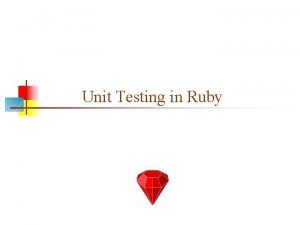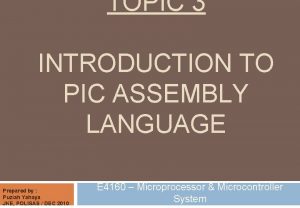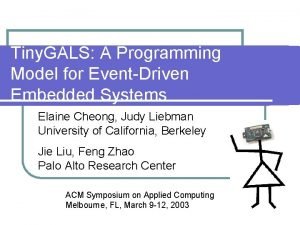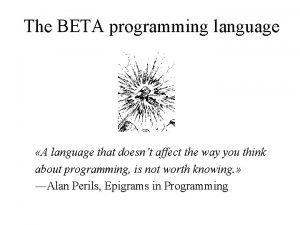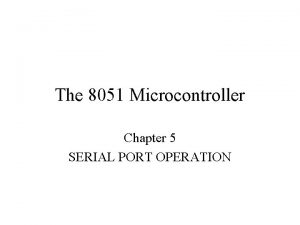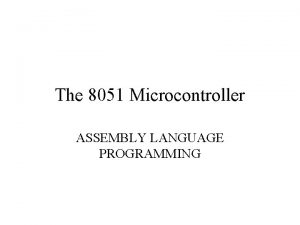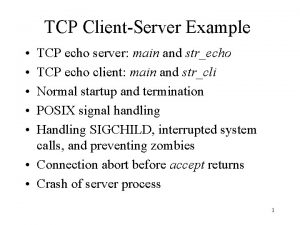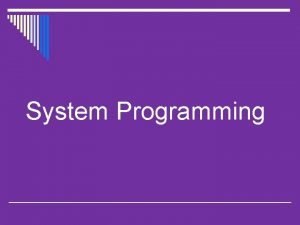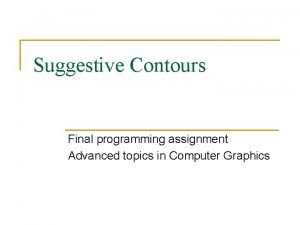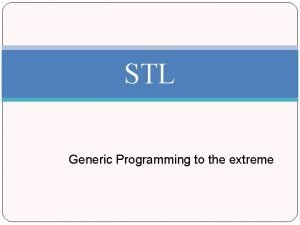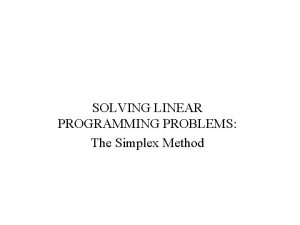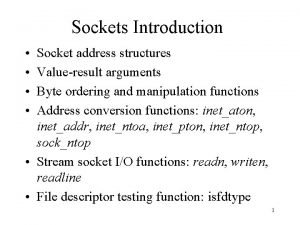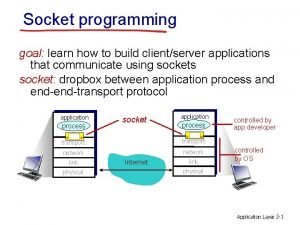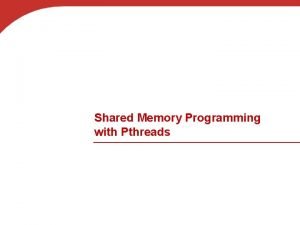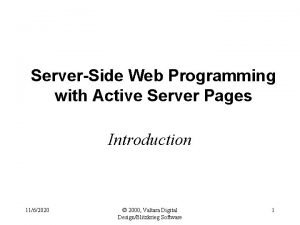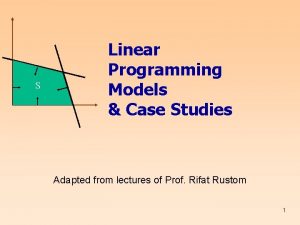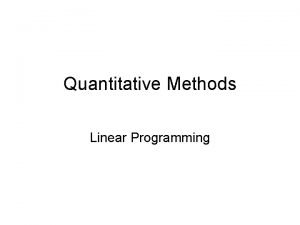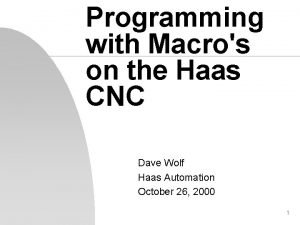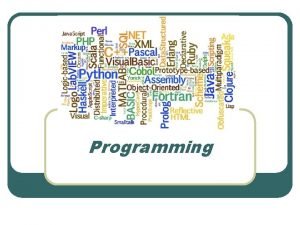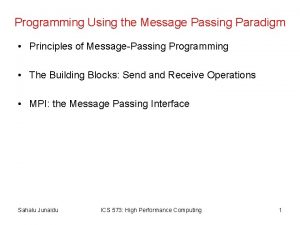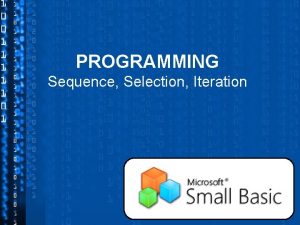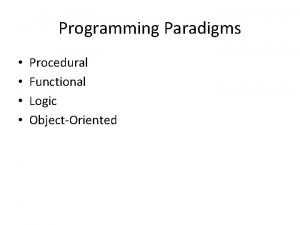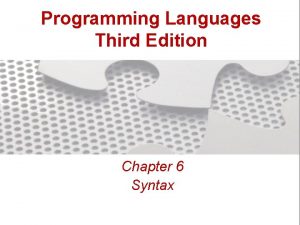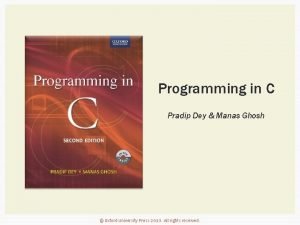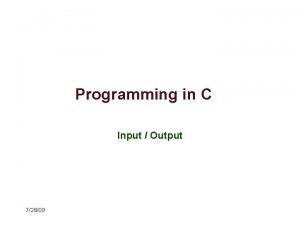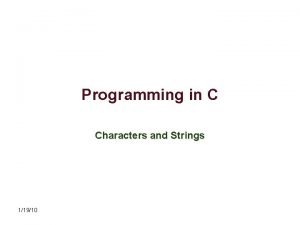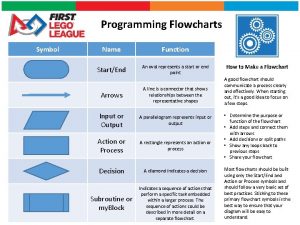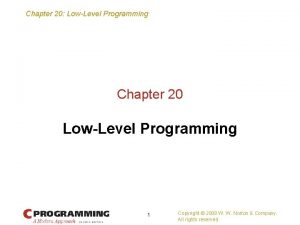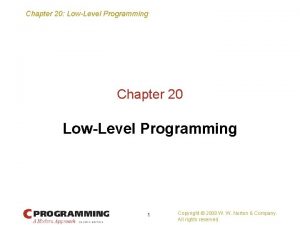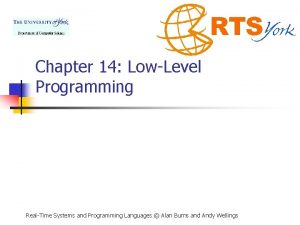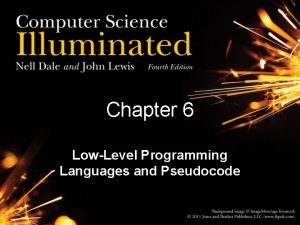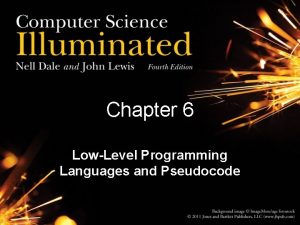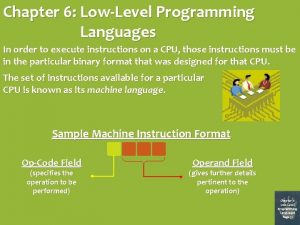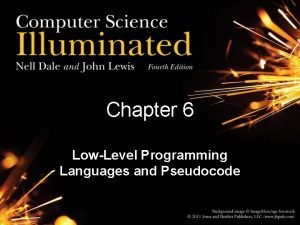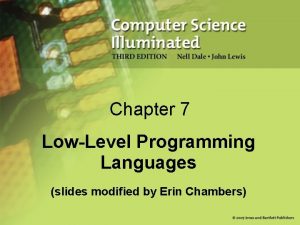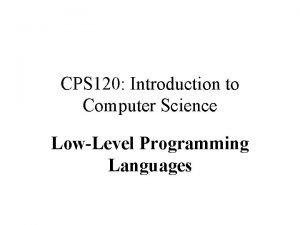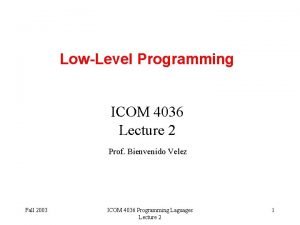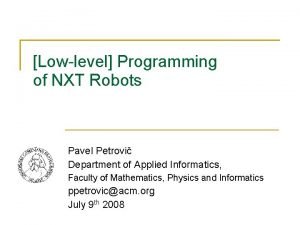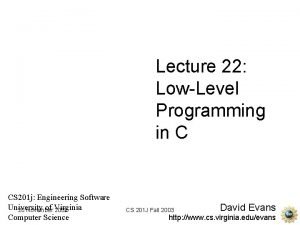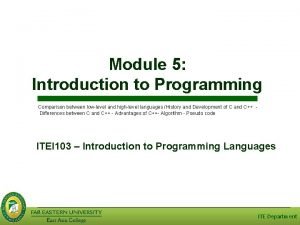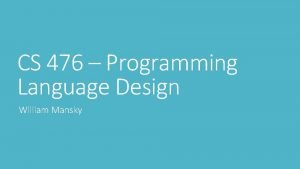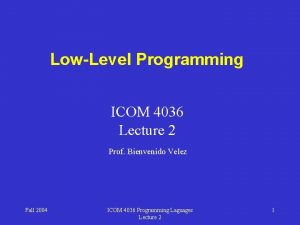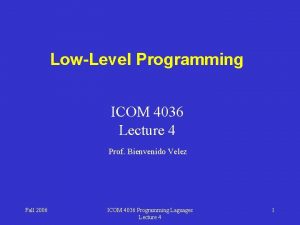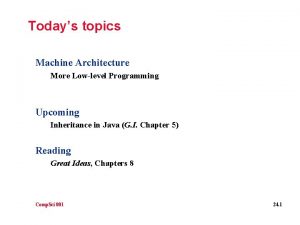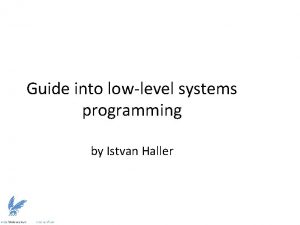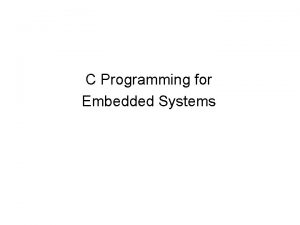Chapter 20 LowLevel Programming Chapter 20 LowLevel Programming




































































- Slides: 68

Chapter 20: Low-Level Programming Chapter 20 Low-Level Programming 1 Copyright © 2008 W. W. Norton & Company. All rights reserved.

Chapter 20: Low-Level Programming Introduction • Previous chapters have described C’s high-level, machine-independent features. • However, some kinds of programs need to perform operations at the bit level: – Systems programs (including compilers and operating systems) – Encryption programs – Graphics programs – Programs for which fast execution and/or efficient use of space is critical 2 Copyright © 2008 W. W. Norton & Company. All rights reserved.

Chapter 20: Low-Level Programming Bitwise Operators • C provides six bitwise operators, which operate on integer data at the bit level. • Two of these operators perform shift operations. • The other four perform bitwise complement, bitwise and, bitwise exclusive or, and bitwise inclusive or operations. 3 Copyright © 2008 W. W. Norton & Company. All rights reserved.

Chapter 20: Low-Level Programming Bitwise Shift Operators • The bitwise shift operators shift the bits in an integer to the left or right: << left shift >> right shift • The operands for << and >> may be of any integer type (including char). • The integer promotions are performed on both operands; the result has the type of the left operand after promotion. 4 Copyright © 2008 W. W. Norton & Company. All rights reserved.

Chapter 20: Low-Level Programming Bitwise Shift Operators • The value of i << j is the result when the bits in i are shifted left by j places. – For each bit that is “shifted off” the left end of i, a zero bit enters at the right. • The value of i >> j is the result when i is shifted right by j places. – If i is of an unsigned type or if the value of i is nonnegative, zeros are added at the left as needed. – If i is negative, the result is implementation-defined. 5 Copyright © 2008 W. W. Norton & Company. All rights reserved.

Chapter 20: Low-Level Programming Bitwise Shift Operators • Examples illustrating the effect of applying the shift operators to the number 13: unsigned short i, j; i = 13; /* i is now 13 (binary 0000001101) */ j = i << 2; /* j is now 52 (binary 00000110100) */ j = i >> 2; /* j is now 3 (binary 000000011) */ 6 Copyright © 2008 W. W. Norton & Company. All rights reserved.

Chapter 20: Low-Level Programming Bitwise Shift Operators • To modify a variable by shifting its bits, use the compound assignment operators <<= and >>=: i = 13; /* i is now 13 (binary 0000001101) */ i <<= 2; /* i is now 52 (binary 00000110100) */ i >>= 2; /* i is now 13 (binary 0000001101) */ 7 Copyright © 2008 W. W. Norton & Company. All rights reserved.

Chapter 20: Low-Level Programming Bitwise Shift Operators • The bitwise shift operators have lower precedence than the arithmetic operators, which can cause surprises: i << 2 + 1 means i << (2 + 1), not (i << 2) + 1 8 Copyright © 2008 W. W. Norton & Company. All rights reserved.

Chapter 20: Low-Level Programming Bitwise Complement, And, Exclusive Or, and Inclusive Or • There are four additional bitwise operators: ~ & ^ | bitwise complement bitwise and bitwise exclusive or bitwise inclusive or • The ~ operator is unary; the integer promotions are performed on its operand. • The other operators are binary; the usual arithmetic conversions are performed on their operands. 9 Copyright © 2008 W. W. Norton & Company. All rights reserved.

Chapter 20: Low-Level Programming Bitwise Complement, And, Exclusive Or, and Inclusive Or • The ~, &, ^, and | operators perform Boolean operations on all bits in their operands. • The ^ operator produces 0 whenever both operands have a 1 bit, whereas | produces 1. 10 Copyright © 2008 W. W. Norton & Company. All rights reserved.

Chapter 20: Low-Level Programming Bitwise Complement, And, Exclusive Or, and Inclusive Or • Examples of the ~, &, ^, and | operators: unsigned short i, j, k; i = 21; /* i is now 21 (binary 00000010101) */ j = 56; /* j is now 56 (binary 00000111000) */ k = ~i; /* k is now 65514 (binary 11111101010) */ k = i & j; /* k is now 16 (binary 00000010000) */ k = i ^ j; /* k is now 45 (binary 00000101101) */ k = i | j; /* k is now 61 (binary 00000111101) */ 11 Copyright © 2008 W. W. Norton & Company. All rights reserved.

Chapter 20: Low-Level Programming Bitwise Complement, And, Exclusive Or, and Inclusive Or • The ~ operator can be used to help make low-level programs more portable. – An integer whose bits are all 1: ~0 – An integer whose bits are all 1 except for the last five: ~0 x 1 f 12 Copyright © 2008 W. W. Norton & Company. All rights reserved.

Chapter 20: Low-Level Programming Bitwise Complement, And, Exclusive Or, and Inclusive Or • Each of the ~, &, ^, and | operators has a different precedence: Highest: ~ & ^ Lowest: | • Examples: i & ~j | k means (i & (~j)) | k i ^ j & ~k means i ^ (j & (~k)) • Using parentheses helps avoid confusion. 13 Copyright © 2008 W. W. Norton & Company. All rights reserved.

Chapter 20: Low-Level Programming Bitwise Complement, And, Exclusive Or, and Inclusive Or • The compound assignment operators &=, ^=, and |= correspond to the bitwise operators &, ^, and |: i = 21; /* i is now 21 (binary 00000010101) */ j = 56; /* j is now 56 (binary 00000111000) */ i &= j; /* i is now 16 (binary 00000010000) */ i ^= j; /* i is now 40 (binary 00000101000) */ i |= j; /* i is now 56 (binary 00000111000) */ 14 Copyright © 2008 W. W. Norton & Company. All rights reserved.

Chapter 20: Low-Level Programming Using the Bitwise Operators to Access Bits • The bitwise operators can be used to extract or modify data stored in a small number of bits. • Common single-bit operations: – Setting a bit – Clearing a bit – Testing a bit • Assumptions: – i is a 16 -bit unsigned short variable. – The leftmost—or most significant—bit is numbered 15 and the least significant is numbered 0. 15 Copyright © 2008 W. W. Norton & Company. All rights reserved.

Chapter 20: Low-Level Programming Using the Bitwise Operators to Access Bits • Setting a bit. The easiest way to set bit 4 of i is to or the value of i with the constant 0 x 0010: i = 0 x 0000; /* i is now 00000000 */ i |= 0 x 0010; /* i is now 00000010000 */ • If the position of the bit is stored in the variable j, a shift operator can be used to create the mask: i |= 1 << j; /* sets bit j */ • Example: If j has the value 3, then 1 << j is 0 x 0008. 16 Copyright © 2008 W. W. Norton & Company. All rights reserved.

Chapter 20: Low-Level Programming Using the Bitwise Operators to Access Bits • Clearing a bit. Clearing bit 4 of i requires a mask with a 0 bit in position 4 and 1 bits everywhere else: i = 0 x 00 ff; /* i is now 00001111 */ i &= ~0 x 0010; /* i is now 000011101111 */ • A statement that clears a bit whose position is stored in a variable: i &= ~(1 << j); /* clears bit j */ 17 Copyright © 2008 W. W. Norton & Company. All rights reserved.

Chapter 20: Low-Level Programming Using the Bitwise Operators to Access Bits • Testing a bit. An if statement that tests whether bit 4 of i is set: if (i & 0 x 0010) … /* tests bit 4 */ • A statement that tests whether bit j is set: if (i & 1 << j) … /* tests bit j */ 18 Copyright © 2008 W. W. Norton & Company. All rights reserved.

Chapter 20: Low-Level Programming Using the Bitwise Operators to Access Bits • Working with bits is easier if they are given names. • Suppose that bits 0, 1, and 2 of a number correspond to the colors blue, green, and red, respectively. • Names that represent the three bit positions: #define BLUE 1 #define GREEN 2 #define RED 4 19 Copyright © 2008 W. W. Norton & Company. All rights reserved.

Chapter 20: Low-Level Programming Using the Bitwise Operators to Access Bits • Examples of setting, clearing, and testing the BLUE bit: i |= BLUE; /* sets BLUE bit */ i &= ~BLUE; /* clears BLUE bit */ if (i & BLUE) … /* tests BLUE bit */ 20 Copyright © 2008 W. W. Norton & Company. All rights reserved.

Chapter 20: Low-Level Programming Using the Bitwise Operators to Access Bits • It’s also easy to set, clear, or test several bits at time: i |= BLUE | GREEN; /* sets BLUE and GREEN bits */ i &= ~(BLUE | GREEN); /* clears BLUE and GREEN bits */ if (i & (BLUE | GREEN)) … /* tests BLUE and GREEN bits */ • The if statement tests whether either the BLUE bit or the GREEN bit is set. 21 Copyright © 2008 W. W. Norton & Company. All rights reserved.

Chapter 20: Low-Level Programming Using the Bitwise Operators to Access Bit-Fields • Dealing with a group of several consecutive bits (a bit-field) is slightly more complicated than working with single bits. • Common bit-field operations: – Modifying a bit-field – Retrieving a bit-field 22 Copyright © 2008 W. W. Norton & Company. All rights reserved.

Chapter 20: Low-Level Programming Using the Bitwise Operators to Access Bit-Fields • Modifying a bit-field requires two operations: – A bitwise and (to clear the bit-field) – A bitwise or (to store new bits in the bit-field) • Example: i = i & ~0 x 0070 | 0 x 0050; /* stores 101 in bits 4 -6 */ • The & operator clears bits 4– 6 of i; the | operator then sets bits 6 and 4. 23 Copyright © 2008 W. W. Norton & Company. All rights reserved.

Chapter 20: Low-Level Programming Using the Bitwise Operators to Access Bit-Fields • To generalize the example, assume that j contains the value to be stored in bits 4– 6 of i. • j will need to be shifted into position before the bitwise or is performed: i = (i & ~0 x 0070) | (j << 4); /* stores j in bits 4 -6 */ • The | operator has lower precedence than & and <<, so the parentheses can be dropped: i = i & ~0 x 0070 | j << 4; 24 Copyright © 2008 W. W. Norton & Company. All rights reserved.

Chapter 20: Low-Level Programming Using the Bitwise Operators to Access Bit-Fields • Retrieving a bit-field. Fetching a bit-field at the right end of a number (in the least significant bits) is easy: j = i & 0 x 0007; /* retrieves bits 0 -2 */ • If the bit-field isn’t at the right end of i, we can first shift the bit-field to the end before extracting the field using the & operator: j = (i >> 4) & 0 x 0007; /* retrieves bits 4 -6 */ 25 Copyright © 2008 W. W. Norton & Company. All rights reserved.

Chapter 20: Low-Level Programming Program: XOR Encryption • One of the simplest ways to encrypt data is to exclusive-or (XOR) each character with a secret key. • Suppose that the key is the & character. • XORing this key with the character z yields the character: 00100110 (ASCII code for &) XOR 01111010 (ASCII code for z) 01011100 (ASCII code for ) 26 Copyright © 2008 W. W. Norton & Company. All rights reserved.

Chapter 20: Low-Level Programming Program: XOR Encryption • Decrypting a message is done by applying the same algorithm: 00100110 (ASCII code for &) XOR 01011100 (ASCII code for ) 01111010 (ASCII code for z) 27 Copyright © 2008 W. W. Norton & Company. All rights reserved.

Chapter 20: Low-Level Programming Program: XOR Encryption • The xor. c program encrypts a message by XORing each character with the & character. • The original message can be entered by the user or read from a file using input redirection. • The encrypted message can be viewed on the screen or saved in a file using output redirection. 28 Copyright © 2008 W. W. Norton & Company. All rights reserved.

Chapter 20: Low-Level Programming Program: XOR Encryption • A sample file named msg: Trust not him with your secrets, who, when left alone in your room, turns over your papers. --Johann Kaspar Lavater (1741 -1801) • A command that encrypts msg, saving the encrypted message in newmsg: xor <msg >newmsg • Contents of newmsg: r. TSUR HIR NOK QORN _IST UCETCRU, QNI, QNCH JC@R GJIHC OH _IST TIIK, RSTHU IPCT _IST VGVCTU. --l. INGHH m. GUVGT j. GPGRCT (1741 -1801) 29 Copyright © 2008 W. W. Norton & Company. All rights reserved.

Chapter 20: Low-Level Programming Program: XOR Encryption • A command that recovers the original message and displays it on the screen: xor <newmsg 30 Copyright © 2008 W. W. Norton & Company. All rights reserved.

Chapter 20: Low-Level Programming Program: XOR Encryption • The xor. c program won’t change some characters, including digits. • XORing these characters with & would produce invisible control characters, which could cause problems with some operating systems. • The program checks whether both the original character and the new (encrypted) character are printing characters. • If not, the program will write the original character instead of the new character. 31 Copyright © 2008 W. W. Norton & Company. All rights reserved.

Chapter 20: Low-Level Programming xor. c /* Performs XOR encryption */ #include <ctype. h> #include <stdio. h> #define KEY '&' int main(void) { int orig_char, new_char; while ((orig_char = getchar()) != EOF) { new_char = orig_char ^ KEY; if (isprint(orig_char) && isprint(new_char)) putchar(new_char); else putchar(orig_char); } return 0; } 32 Copyright © 2008 W. W. Norton & Company. All rights reserved.

Chapter 20: Low-Level Programming Bit-Fields in Structures • The bit-field techniques discussed previously can be tricky to use and potentially confusing. • Fortunately, C provides an alternative: declaring structures whose members represent bit-fields. 33 Copyright © 2008 W. W. Norton & Company. All rights reserved.

Chapter 20: Low-Level Programming Bit-Fields in Structures • Example: How DOS stores the date at which a file was created or last modified. • Since days, months, and years are small numbers, storing them as normal integers would waste space. • Instead, DOS allocates only 16 bits for a date, with 5 bits for the day, 4 bits for the month, and 7 bits for the year: 34 Copyright © 2008 W. W. Norton & Company. All rights reserved.

Chapter 20: Low-Level Programming Bit-Fields in Structures • A C structure that uses bit-fields to create an identical layout: struct file_date { unsigned int day: 5; unsigned int month: 4; unsigned int year: 7; }; • A condensed version: struct file_date { unsigned int day: 5, month: 4, year: 7; }; 35 Copyright © 2008 W. W. Norton & Company. All rights reserved.

Chapter 20: Low-Level Programming Bit-Fields in Structures • The type of a bit-field must be either int, unsigned int, or signed int. • Using int is ambiguous; some compilers treat the field’s high-order bit as a sign bit, but others don’t. • In C 99, bit-fields may also have type _Bool. • C 99 compilers may allow additional bit-field types. 36 Copyright © 2008 W. W. Norton & Company. All rights reserved.

Chapter 20: Low-Level Programming Bit-Fields in Structures • A bit-field can be used in the same way as any other member of a structure: struct file_date fd; fd. day = 28; fd. month = 12; fd. year = 8; /* represents 1988 */ • Appearance of the fd variable after these assignments: 37 Copyright © 2008 W. W. Norton & Company. All rights reserved.

Chapter 20: Low-Level Programming Bit-Fields in Structures • The address operator (&) can’t be applied to a bitfield. • Because of this rule, functions such as scanf can’t store data directly in a bit-field: scanf("%d", &fd. day); /*** WRONG ***/ • We can still use scanf to read input into an ordinary variable and then assign it to fd. day. 38 Copyright © 2008 W. W. Norton & Company. All rights reserved.

Chapter 20: Low-Level Programming How Bit-Fields Are Stored • The C standard allows the compiler considerable latitude in choosing how it stores bit-fields. • The rules for handling bit-fields depend on the notion of “storage units. ” • The size of a storage unit is implementationdefined. – Typical values are 8 bits, 16 bits, and 32 bits. 39 Copyright © 2008 W. W. Norton & Company. All rights reserved.

Chapter 20: Low-Level Programming How Bit-Fields Are Stored • The compiler packs bit-fields one by one into a storage unit, with no gaps between the fields, until there’s not enough room for the next field. • At that point, some compilers skip to the beginning of the next storage unit, while others split the bit-field across the storage units. • The order in which bit-fields are allocated (left to right or right to left) is also implementationdefined. 40 Copyright © 2008 W. W. Norton & Company. All rights reserved.

Chapter 20: Low-Level Programming How Bit-Fields Are Stored • Assumptions in the file_date example: – Storage units are 16 bits long. – Bit-fields are allocated from right to left (the first bitfield occupies the low-order bits). • An 8 -bit storage unit is also acceptable if the compiler splits the month field across two storage units. 41 Copyright © 2008 W. W. Norton & Company. All rights reserved.

Chapter 20: Low-Level Programming How Bit-Fields Are Stored • The name of a bit-field can be omitted. • Unnamed bit-fields are useful as “padding” to ensure that other bit-fields are properly positioned. • A structure that stores the time associated with a DOS file: struct file_time { unsigned int seconds: 5; unsigned int minutes: 6; unsigned int hours: 5; }; 42 Copyright © 2008 W. W. Norton & Company. All rights reserved.

Chapter 20: Low-Level Programming How Bit-Fields Are Stored • The same structure with the name of the seconds field omitted: struct file_time { unsigned int : 5; /* not used */ unsigned int minutes: 6; unsigned int hours: 5; }; • The remaining bit-fields will be aligned as if seconds were still present. 43 Copyright © 2008 W. W. Norton & Company. All rights reserved.

Chapter 20: Low-Level Programming How Bit-Fields Are Stored • The length of an unnamed bit-field can be 0: struct s { unsigned int a: 4; unsigned int : 0; /* 0 -length bit-field */ unsigned int b: 8; }; • A 0 -length bit-field tells the compiler to align the following bit-field at the beginning of a storage unit. – If storage units are 8 bits long, the compiler will allocate 4 bits for a, skip 4 bits to the next storage unit, and then allocate 8 bits for b. – If storage units are 16 bits long, the compiler will allocate 4 bits for a, skip 12 bits, and then allocate 8 bits for b. 44 Copyright © 2008 W. W. Norton & Company. All rights reserved.

Chapter 20: Low-Level Programming Other Low-Level Techniques • Some features covered in previous chapters are used often in low-level programming. • Examples: – Defining types that represent units of storage – Using unions to bypass normal type-checking – Using pointers as addresses • The volatile type qualifier was mentioned in Chapter 18 but not discussed because of its lowlevel nature. 45 Copyright © 2008 W. W. Norton & Company. All rights reserved.

Chapter 20: Low-Level Programming Defining Machine-Dependent Types • The char type occupies one byte, so characters can be treated as bytes. • It’s a good idea to define a BYTE type: typedef unsigned char BYTE; • Depending on the machine, additional types may be needed. • A useful type for the x 86 platform: typedef unsigned short WORD; 46 Copyright © 2008 W. W. Norton & Company. All rights reserved.

Chapter 20: Low-Level Programming Using Unions to Provide Multiple Views of Data • Unions can be used in a portable way, as shown in Chapter 16. • However, they’re often used in C for an entirely different purpose: viewing a block of memory in two or more different ways. • Consider the file_date structure described earlier. • A file_date structure fits into two bytes, so any two-byte value can be thought of as a file_date structure. 47 Copyright © 2008 W. W. Norton & Company. All rights reserved.

Chapter 20: Low-Level Programming Using Unions to Provide Multiple Views of Data • In particular, an unsigned short value can be viewed as a file_date structure. • A union that can be used to convert a short integer to a file date or vice versa: union int_date { unsigned short i; struct file_date fd; }; 48 Copyright © 2008 W. W. Norton & Company. All rights reserved.

Chapter 20: Low-Level Programming Using Unions to Provide Multiple Views of Data • A function that prints an unsigned short argument as a file date: void print_date(unsigned short n) { union int_date u; u. i = n; printf("%d/%d/%dn", u. fd. month, u. fd. day, u. fd. year + 1980); } 49 Copyright © 2008 W. W. Norton & Company. All rights reserved.

Chapter 20: Low-Level Programming Using Unions to Provide Multiple Views of Data • Using unions to allow multiple views of data is especially useful when working with registers, which are often divided into smaller units. • x 86 processors have 16 -bit registers named AX, BX, CX, and DX. • Each register can be treated as two 8 -bit registers. – AX is divided into registers named AH and AL. 50 Copyright © 2008 W. W. Norton & Company. All rights reserved.

Chapter 20: Low-Level Programming Using Unions to Provide Multiple Views of Data • Writing low-level applications for x 86 -based computers may require variables that represent AX, BX, CX, and DX. • The goal is to access both the 16 - and 8 -bit registers, taking their relationships into account. – A change to AX affects both AH and AL; changing AH or AL modifies AX. • The solution is to set up two structures: – The members of one correspond to the 16 -bit registers. – The members of the other match the 8 -bit registers. 51 Copyright © 2008 W. W. Norton & Company. All rights reserved.

Chapter 20: Low-Level Programming Using Unions to Provide Multiple Views of Data • A union that encloses the two structures: union { struct { WORD ax, bx, cx, dx; } word; struct { BYTE al, ah, bl, bh, cl, ch, dl, dh; } byte; } regs; 52 Copyright © 2008 W. W. Norton & Company. All rights reserved.

Chapter 20: Low-Level Programming Using Unions to Provide Multiple Views of Data • The members of the word structure will be overlaid with the members of the byte structure. – ax will occupy the same memory as al and ah. • An example showing how the regs union might be used: regs. byte. ah = 0 x 12; regs. byte. al = 0 x 34; printf("AX: %hxn", regs. word. ax); • Output: AX: 1234 53 Copyright © 2008 W. W. Norton & Company. All rights reserved.

Chapter 20: Low-Level Programming Using Unions to Provide Multiple Views of Data • Note that the byte structure lists al before ah. • When a data item consists of more than one byte, there are two logical ways to store it in memory: – Big-endian: Bytes are stored in “natural” order (the leftmost byte comes first). – Little-endian: Bytes are stored in reverse order (the leftmost byte comes last). • x 86 processors use little-endian order. 54 Copyright © 2008 W. W. Norton & Company. All rights reserved.

Chapter 20: Low-Level Programming Using Unions to Provide Multiple Views of Data • We don’t normally need to worry about byte ordering. • However, programs that deal with memory at a low level must be aware of the order in which bytes are stored. • It’s also relevant when working with files that contain non-character data. 55 Copyright © 2008 W. W. Norton & Company. All rights reserved.

Chapter 20: Low-Level Programming Using Pointers as Addresses • An address often has the same number of bits as an integer (or long integer). • Creating a pointer that represents a specific address is done by casting an integer to a pointer: BYTE *p; p = (BYTE *) 0 x 1000; /* p contains address 0 x 1000 */ 56 Copyright © 2008 W. W. Norton & Company. All rights reserved.

Chapter 20: Low-Level Programming Program: Viewing Memory Locations • The viewmemory. c program allows the user to view segments of computer memory. • The program first displays the address of its own main function as well as the address of one of its variables. • The program next prompts the user to enter an address (as a hexadecimal integer) plus the number of bytes to view. • The program then displays a block of bytes of the chosen length, starting at the specified address. 57 Copyright © 2008 W. W. Norton & Company. All rights reserved.

Chapter 20: Low-Level Programming Program: Viewing Memory Locations • Bytes are displayed in groups of 10 (except for the last group). • Bytes are shown both as hexadecimal numbers and as characters. • Only printing characters are displayed; other characters are shown as periods. • The program assumes that int values and addresses are stored using 32 bits. • Addresses are displayed in hexadecimal. 58 Copyright © 2008 W. W. Norton & Company. All rights reserved.

Chapter 20: Low-Level Programming viewmemory. c /* Allows the user to view regions of computer memory */ #include <ctype. h> #include <stdio. h> typedef unsigned char BYTE; int main(void) { unsigned int addr; int i, n; BYTE *ptr; printf("Address of main function: %xn", (unsigned int) main); printf("Address of addr variable: %xn", (unsigned int) &addr); 59 Copyright © 2008 W. W. Norton & Company. All rights reserved.

Chapter 20: Low-Level Programming printf("n. Enter a (hex) address: "); scanf("%x", &addr); printf("Enter number of bytes to view: "); scanf("%d", &n); printf("n"); printf(" Address Bytes Charactersn"); printf(" ------------------n"); 60 Copyright © 2008 W. W. Norton & Company. All rights reserved.

Chapter 20: Low-Level Programming ptr = (BYTE *) addr; for (; n > 0; n -= 10) { printf("%8 X ", (unsigned int) ptr); for (i = 0; i < 10 && i < n; i++) printf("%. 2 X ", *(ptr + i)); for (; i < 10; i++) printf(" "); printf(" "); for (i = 0; i < 10 && i < n; i++) { BYTE ch = *(ptr + i); if (!isprint(ch)) ch = '. '; printf("%c", ch); } printf("n"); ptr += 10; } return 0; } 61 Copyright © 2008 W. W. Norton & Company. All rights reserved.

Chapter 20: Low-Level Programming Program: Viewing Memory Locations • Sample output using GCC on an x 86 system running Linux: Address of main function: 804847 c Address of addr variable: bff 41154 Enter a (hex) address: 8048000 Enter number of bytes to view: 40 Address Bytes Characters ------------------ 8048000 7 F 45 4 C 46 01 01 01 00 00 00 . ELF. . . 804800 A 00 00 00 02 00 03 00 . . 8048014 01 00 00 00 C 0 83 04 08 34 00 . . . . 4. 804801 E 00 00 C 0 0 A 00 00 00 . . • The 7 F byte followed by the letters E, L, and F identify the format (ELF) in which the executable file was stored. 62 Copyright © 2008 W. W. Norton & Company. All rights reserved.

Chapter 20: Low-Level Programming Program: Viewing Memory Locations • A sample that displays bytes starting at the address of addr: Address of main function: 804847 c Address of addr variable: bfec 5484 Enter a (hex) address: bfec 5484 Enter number of bytes to view: 64 Address Bytes Characters ------------------BFEC 5484 84 54 EC BF B 0 54 EC BF F 4 6 F . T. . . o BFEC 548 E 68 00 34 55 EC BF C 0 54 EC BF h. 4 U. . . T. . BFEC 5498 08 55 EC BF E 3 3 D 57 00 00 00 . U. . . =W. . . BFEC 54 A 2 00 00 A 0 BC 55 00 08 55 EC BF . . U. . BFEC 54 AC E 3 3 D 57 00 01 00 00 00 34 55 . =W. . . 4 U BFEC 54 B 6 EC BF 3 C 55 EC BF 56 11 55 00 . . <U. . V. U. BFEC 54 C 0 F 4 6 F 68 00 . oh. • When reversed, the first four bytes form the number BFEC 5484, the address entered by the user. 63 Copyright © 2008 W. W. Norton & Company. All rights reserved.

Chapter 20: Low-Level Programming The volatile Type Qualifier • On some computers, certain memory locations are “volatile. ” • The value stored at such a location can change as a program is running, even though the program itself isn’t storing new values there. • For example, some memory locations might hold data coming directly from input devices. 64 Copyright © 2008 W. W. Norton & Company. All rights reserved.

Chapter 20: Low-Level Programming The volatile Type Qualifier • The volatile type qualifier allows us to inform the compiler if any of the data used in a program is volatile. • volatile typically appears in the declaration of a pointer variable that will point to a volatile memory location: volatile BYTE *p; /* p will point to a volatile byte */ 65 Copyright © 2008 W. W. Norton & Company. All rights reserved.

Chapter 20: Low-Level Programming The volatile Type Qualifier • Suppose that p points to a memory location that contains the most recent character typed at the user’s keyboard. • A loop that obtains characters from the keyboard and stores them in a buffer array: while (buffer not full) { wait for input; buffer[i] = *p; if (buffer[i++] == 'n') break; } 66 Copyright © 2008 W. W. Norton & Company. All rights reserved.

Chapter 20: Low-Level Programming The volatile Type Qualifier • A sophisticated compiler might notice that this loop changes neither p nor *p. • It could optimize the program by altering it so that *p is fetched just once: store *p in a register; while (buffer not full) { wait for input; buffer[i] = value stored in register; if (buffer[i++] == 'n') break; } 67 Copyright © 2008 W. W. Norton & Company. All rights reserved.

Chapter 20: Low-Level Programming The volatile Type Qualifier • The optimized program will fill the buffer with many copies of the same character. • Declaring that p points to volatile data avoids this problem by telling the compiler that *p must be fetched from memory each time it’s needed. 68 Copyright © 2008 W. W. Norton & Company. All rights reserved.
 Perbedaan linear programming dan integer programming
Perbedaan linear programming dan integer programming Greedy vs dynamic programming
Greedy vs dynamic programming Windows 10 system programming, part 1
Windows 10 system programming, part 1 Integer programming vs linear programming
Integer programming vs linear programming Perbedaan linear programming dan integer programming
Perbedaan linear programming dan integer programming Python chapter 5
Python chapter 5 The zj row in a simplex table for maximization represents
The zj row in a simplex table for maximization represents Logical programming language
Logical programming language Chapter 16 programming language
Chapter 16 programming language Qm for windows linear programming
Qm for windows linear programming Computer programming chapter 1
Computer programming chapter 1 C programming chapter 1
C programming chapter 1 Chapter 1 introduction to computers and programming
Chapter 1 introduction to computers and programming Computer programming chapter 1
Computer programming chapter 1 Chapter 8 linear programming applications solutions
Chapter 8 linear programming applications solutions Chapter 2 elementary programming
Chapter 2 elementary programming Chapter 16 programming language
Chapter 16 programming language Chapter 1 introduction to computers and programming
Chapter 1 introduction to computers and programming What is scrath
What is scrath Dts garage motor
Dts garage motor Gcom 520 manual
Gcom 520 manual Dts gate motor 4 beeps
Dts gate motor 4 beeps Vba object oriented
Vba object oriented Programming language level virtualization
Programming language level virtualization Unit testing ruby
Unit testing ruby Imperative statement in system programming
Imperative statement in system programming Computational thinking algorithms and programming
Computational thinking algorithms and programming Pic assembly instructions
Pic assembly instructions Tiny gals is a programming model for
Tiny gals is a programming model for Cern programming language
Cern programming language Extreme programming advantages and disadvantages
Extreme programming advantages and disadvantages Beta language
Beta language How many serial ports are there in 8051 microcontroller
How many serial ports are there in 8051 microcontroller Microcontroller assembly language programming
Microcontroller assembly language programming Virginia tech high school programming contest
Virginia tech high school programming contest Virginia tech high school programming contest
Virginia tech high school programming contest Socket programming in c
Socket programming in c Tcp echo server
Tcp echo server Declarative statement in assembly language
Declarative statement in assembly language Suggestive programming
Suggestive programming Stochastic programming
Stochastic programming Generic programming and the stl
Generic programming and the stl Linear programming problems and solutions doc
Linear programming problems and solutions doc Value result arguments
Value result arguments Tcp udp socket programming in java
Tcp udp socket programming in java Welcoming socket
Welcoming socket Shortest path linear programming
Shortest path linear programming Sic machine architecture
Sic machine architecture Canonical form linear programming
Canonical form linear programming Shared memory programming
Shared memory programming Introduction to server side programming
Introduction to server side programming What is baud rate in 8051
What is baud rate in 8051 Linear programming case study examples
Linear programming case study examples Ruby gui programming
Ruby gui programming Real-time systems and programming languages
Real-time systems and programming languages Non negativity constraints
Non negativity constraints Cnc macro programming
Cnc macro programming Android network programming
Android network programming Lll programming language
Lll programming language Principles of message passing programming
Principles of message passing programming What is sequence selection iteration programming
What is sequence selection iteration programming Procedural vs functional
Procedural vs functional Programming massively parallel processors
Programming massively parallel processors Syntax vs semantics
Syntax vs semantics Cs 421 programming languages and compilers
Cs 421 programming languages and compilers Pradip dey and manas ghosh programming in c
Pradip dey and manas ghosh programming in c Stdin in c
Stdin in c %3 ascii
%3 ascii Flowchart symbol names
Flowchart symbol names






